October 22, 2021
I have a deep fondness (I know, this is, oh, a little patting-yourself-on-the-back-y) for some of the headnotes (the intro paragraph/graphs before the recipe, though you probably knew that) in Ginger Bliss and the Violet Fizz. Including the one for this drink, which is short, but still I hope fun, and introduces the players and such. So much so that I’m going to just do the ol’ cut-and-pasting of said intro right here:
Featuring the bracing and bountiful bam! of Italian digestivo Fernet-Branca over a layer of rumbling dark rum and a lovely lash of apricot liqueur and a tiny tang of lime, the Whip should be unveiled only when attempting world conquest (in the board game Risk, that is) or having a marathon video game session when the games are medieval or oriented earlier (such as Prince of Persia, say) or having a double elimination (’cause every player needs a second chance) shuffleboard tournament where the winner triumphs thanks to the singular method of ricocheting the puck off the sidewalls to hang gracefully on the board’s edge—without falling over. A conqueror indeed.

The Whip of the Conqueror, from Ginger Bliss and the Violet Fizz
Ice cubes
1 -1/2 ounces dark rum
1 ounce Fernet Branca
1/2 ounce apricot liqueur
1/4 ounce freshly squeezed lime juice
Lime twist, for garnish
1. Fill a cocktail shaker halfway full with ice cubes. Add the rum, Fernet Branca, apricot liqueur, and lime juice. Shake while longing to be the conqueror.
2. Strain through a fine strainer into a cocktail glass, and garnish with the twist.
Tags: apricot liqueur, cocktail, Cocktail Recipes, dark rum, Fernet Branca, Friday Night Cocktail, Ginger Bliss and the Violet Fizz, lime juice, The Whip of the Conqueror, What I’m Drinking
Posted in: Cocktail Recipes, Fernet Branca, Ginger Bliss and the Violet Fizz, Italy, Liqueurs, Recipes, Rum, What I'm Drinking
October 15, 2011
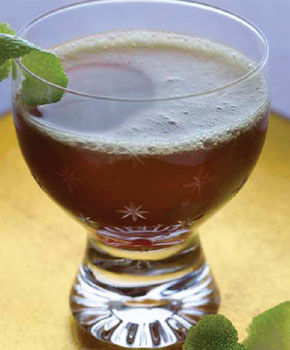 They said it couldn’t be done! They said that dark rum, Fernet-Branca, apricot liqueur, and lime couldn’t be mixed together! They said that Ginger Bliss and the Violet Fizz couldn’t contain a drink that contains said ingredients, and they said it couldn’t be delicious, herbal, and tangy all at once! They said that a drink named after a whip and a world-beater (or, conqueror) couldn’t be made, that the good people of this here earth I stand on wouldn’t sip it up like the nectar of the gods! They said that it wouldn’t be an ideal mixture for Fall’s cold days, and that it wouldn’t slide the chill right off like a loose negligee! They said, they said, they said. Who is they (you might say)? Well, I’m not 100% sure. But they’re bad people. Unlike you and I. Both of whom (I sure hope) love this drink.
They said it couldn’t be done! They said that dark rum, Fernet-Branca, apricot liqueur, and lime couldn’t be mixed together! They said that Ginger Bliss and the Violet Fizz couldn’t contain a drink that contains said ingredients, and they said it couldn’t be delicious, herbal, and tangy all at once! They said that a drink named after a whip and a world-beater (or, conqueror) couldn’t be made, that the good people of this here earth I stand on wouldn’t sip it up like the nectar of the gods! They said that it wouldn’t be an ideal mixture for Fall’s cold days, and that it wouldn’t slide the chill right off like a loose negligee! They said, they said, they said. Who is they (you might say)? Well, I’m not 100% sure. But they’re bad people. Unlike you and I. Both of whom (I sure hope) love this drink.
Ice cubes
1 -1/2 ounces dark rum
1 ounce Fernet-Branca
1/2 ounce apricot liqueur
1/4 ounce freshly squeezed lime juice
Lime twist, for garnish
1. Fill a cocktail shaker halfway full with ice cubes. Add the rum, Fernet-Branca, apricot liqueur, and lime juice. Shake in a whip-cracking motion.
2. Strain into a cocktail glass, and garnish with the lime whip. Oh, I mean twist.
Tags: apricot liqueur, cocktail recipe, Cocktail Recipes, Fernet Branca, Ginger Bliss and the Violet Fizz, Rum, What I'm Drinking
Posted in: Almost Drinkable Photo, Fernet Branca, Ginger Bliss and the Violet Fizz, Liqueurs, Recipes, Rum, What I'm Drinking
July 22, 2011
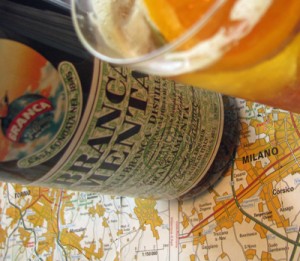 If you’re a regular reader of the Spiked Punch blog (and if you aren’t, why, may I ask, aren’t you? Cause I like you lots. Lots. So much that I want you here, reading, all the time. As long as that doesn’t sound creepy), you know that I was lucky enough to visit the Branca distillery, cause I distilled the visit in Branca Tour 1 and Branca Tour 2. What I may not have hit on enough in either of those articles is how that visit spurred on my love of Branca Menta (my love of Fernet Branca and the vermouths mentioned in those posts was pretty high already). Especially in these summer months, I actually drink more of the more-recent Branca, the Menta. Why, you might ask? Well, I detail the why, as well as give a recipe for the Menta Highball, and talk more Branca and Milan (where it’s made) in this article for the Good Life Report, called Make It a Milan Menta Summer. So get your-own summer-drink luvin’ self over there and start reading.
If you’re a regular reader of the Spiked Punch blog (and if you aren’t, why, may I ask, aren’t you? Cause I like you lots. Lots. So much that I want you here, reading, all the time. As long as that doesn’t sound creepy), you know that I was lucky enough to visit the Branca distillery, cause I distilled the visit in Branca Tour 1 and Branca Tour 2. What I may not have hit on enough in either of those articles is how that visit spurred on my love of Branca Menta (my love of Fernet Branca and the vermouths mentioned in those posts was pretty high already). Especially in these summer months, I actually drink more of the more-recent Branca, the Menta. Why, you might ask? Well, I detail the why, as well as give a recipe for the Menta Highball, and talk more Branca and Milan (where it’s made) in this article for the Good Life Report, called Make It a Milan Menta Summer. So get your-own summer-drink luvin’ self over there and start reading.
May 23, 2011
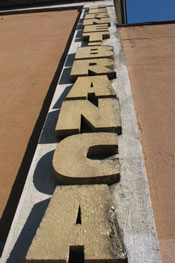 If you haven’t read Part 1 of our Branca Distiller tour, well, do so now. It talks lots about company history, the Collezione Branca, the Branca philosophy of novare serbando (renew but conserve), and much more. Go read it. Okay, are you back? Now we’re ready for Part 2, in which we actually get to walk around the distillery and see where the magic happens. Still with our tour guides Elisa, Marco, and Valeria, we last stopped at the Carpano area of the museum, where we learned more about Branca’s purchase of Carpano Antica (and the full Carpano family of vermouths), had a quick drink of Carpano Antica, and then got ready to hit the distillery proper. But first, as we’re walking into delicate areas, we had to suit up (attractive, aren’t we?):
If you haven’t read Part 1 of our Branca Distiller tour, well, do so now. It talks lots about company history, the Collezione Branca, the Branca philosophy of novare serbando (renew but conserve), and much more. Go read it. Okay, are you back? Now we’re ready for Part 2, in which we actually get to walk around the distillery and see where the magic happens. Still with our tour guides Elisa, Marco, and Valeria, we last stopped at the Carpano area of the museum, where we learned more about Branca’s purchase of Carpano Antica (and the full Carpano family of vermouths), had a quick drink of Carpano Antica, and then got ready to hit the distillery proper. But first, as we’re walking into delicate areas, we had to suit up (attractive, aren’t we?):
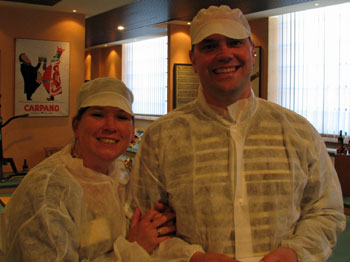
Check out the wonderful Carpano ad in the background, too. Yet another piece of Branca-related advertising I wish I had framed in my house. After suiting up, we started by going through a few doors into the Borghetti coffee liqueur room. Now, here’s where I have to admit one downside for you, dear readers, in this Part 2 of the tour post. We couldn’t, in most areas of the distillery, take pictures. As mentioned in Part 1, having delicious liqueurs, vermouths, and amaros means that folks are always wanting to know how you make them. Which means even someone as un-spy-ish as me (though I could be a spy, I suppose–I have that look, right?) can’t snap snaps. Borghetti, if you don’t know (and you might not, as it’s sadly not readily available in the States) is the coffee liqueur made by the Branca company. It’s a staple in Italy (all the everyday bars/cafes we’d visit had it, usually in both big bottles and in these small, 3-inch-ish, portable bottles), and I’m not 100% sure why we don’t have it in the U.S., as it’s scrumptious. Normally, I’m not either a big coffee liqueur fan or a big coffee drinker (a lot of coffee liqueurs taste ickily chemical to me), but I really love the Borghetti, and after seeing where it’s made, I know why. It only contains coffee (freshly roaster and made there), liquor, and a natural sweetener. Walking into the room where it’s made is somewhat like walking into the best coffee roaster inside Willy Wonka’s chocolate factory, as there’s a perfect sweet/coffee aroma—which matches Broghetti’s taste. Here’s what the bottle looks like, if you want to scoop some up on your travels:
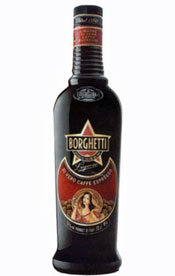
From there, we saw where the ingredients in Fernet Branca are treated during production (where the secret processes mentioned in Part 1 happen), including the big iron pot (pictured in Part 1) where the spices and more are stirred up. Amazing stuff, really, as it’s partially mechanized, but still there are always workers in attendance, watching over the process. We next went to perhaps my favorite part of the whole tour (well, just hanging out with our awesome tour guides was my favorite part, but this coming up was a close second), the cask where Stravecchio Branca spends time before bottling. Stravecchio Branca is the brandy made by the Branca company, and is another item I wouldn’t mind seeing more of over here (again, it’s in most bars/cafes in Italy and is a really good, full-bodied brandy). Here’s the bottle if you ever want to try some and you see it:
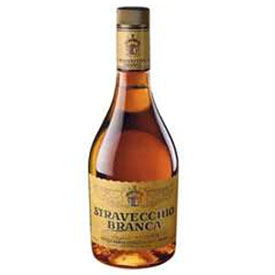
But the cask (or flask, as they referred to it as) in question we could take pics of, but we didn’t have a wide enough angle lens to do it justice. See, it’s the biggest cask in Europe, and was built over a two month time period way back in 1892. And it’s massive and astounding to stand in front of:
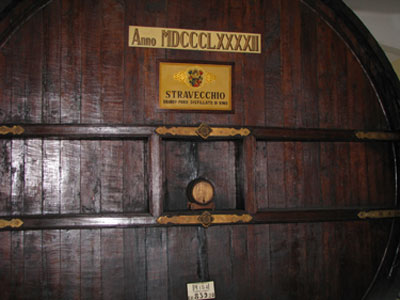
Stravecchio was originally called “Vieux Cognac,” but they had to change the name due to the Cognac rules (about it having to be made in the Cognac region of France, that is). Today, the brandy spends some time in other casks, but each batch spends a least some time in this massive cask–which is never empty, as some is always left in to ensure that the brandy stays consistent (a nice little touch). On the back of the ginormous cask, there’s a chart that tells how full it is (somewhat like the little marks made on the wall as kids get taller), alongside a little chalkboard notepad (which is alongside my head):
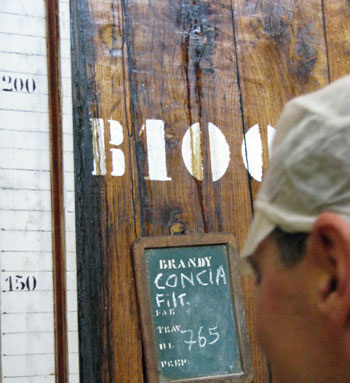
My favorite part of the photo (and another reason why I loved this cask so much) is right above the “B100” where the cask looks like it’s sweating. This is a slight oozing out that happens, about which Marco said, “it is crying.” He even wiped some off on a fingertip to taste, and encouraged us to do the same–which I, naturally did. It was super-brandy-charged, and I dug it so much I went back for more (hey, I have a hard time seeing anything cry). After the Stravecchio, we wandered down into the cellars, where we viewed wooden cask after wooden cask, rows of them (all lovely, by the way), first more brandy (they start here in smaller casks before moving to the biggest cask in Europe), then the wooden casks Fernet Branca is aged within. Fernet Branca has to be aged at least a year, and the brandy for three, so you can imagine that there are tons of casks (not to mention that Branca Menta is also made with aged Fernet Branca, on to which is added pure peppermint oil, sweetening, and love). All these hundreds of casks, the giant cask, the production facilities upstairs, the museum from Part 1, and the offices live in this one building, in the center of Milan, a bustling city. There’s something almost otherworldly about it, especially when wandering through the building’s many rooms and passages. One could easily get lost down here—you’d never go thirsty, luckily. Also luckily, we didn’t have to worry about getting lost, because we were with our friendly and knowledgeable (and fun) tour guides. Check them out, aren’t they great:
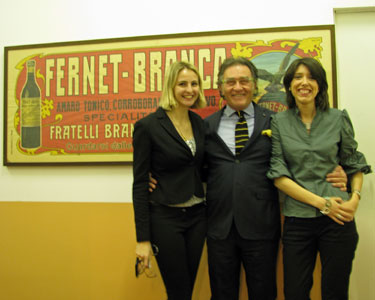
After seeing the casks, and saying our goodbyes, we walked out in Milan craving a little Fernet Branca or Branca Menta. Of course, we had a four-and-a-half hour drive ahead of us, so the cravings just became sharper, until we were back in our home Italian neighborhood, where we could indulge our Branca thirst at Bar Fizz. Thanks again Fratelli Branca Distillerie, we had a great time.
Tags: amaro, Borghetti, Branca Menta, Carpano Antica, Fernet Branca, Fratelli Branca Distillerie, Italian Liqueurs, Italy, Milan, Punt e' Mes, Stravecchio brandy
Posted in: Brandy, digestif, Fernet Branca, Italy, Liqueurs
May 20, 2011
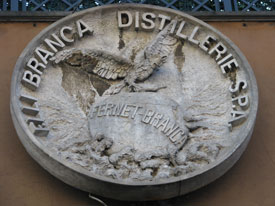 Back in April (when still living in Italy), wife Nat and I took the road north from our Italian pre-tirement home, driving up to Milan so we could make a visit to the Fratelli Branca Distillerie, where Fernet Branca and many other delicious drinkables are made. When we showed up in the morning for our tour, we weren’t sure at all what to expect—a little talking, a little walking around the building, we just didn’t know. But it ended up being an amazing day, where we learned a ton and had some fun (huge props to Laura Baddish for helping to set it up, too). Once past the guards (serious liqueurs always need guards at the gates, cause secret formulas are too tempting to weaker minded individuals), we were met by three swell Italian folks: Elisa, Marco, and Valeria. Marco gave most of the tour, with tons of expert translating (his English is better than our Italian, but not by enough to carry on in-depth conversations) and more touring by Elisa, with Valeria filling in the cracks.
Back in April (when still living in Italy), wife Nat and I took the road north from our Italian pre-tirement home, driving up to Milan so we could make a visit to the Fratelli Branca Distillerie, where Fernet Branca and many other delicious drinkables are made. When we showed up in the morning for our tour, we weren’t sure at all what to expect—a little talking, a little walking around the building, we just didn’t know. But it ended up being an amazing day, where we learned a ton and had some fun (huge props to Laura Baddish for helping to set it up, too). Once past the guards (serious liqueurs always need guards at the gates, cause secret formulas are too tempting to weaker minded individuals), we were met by three swell Italian folks: Elisa, Marco, and Valeria. Marco gave most of the tour, with tons of expert translating (his English is better than our Italian, but not by enough to carry on in-depth conversations) and more touring by Elisa, with Valeria filling in the cracks.
The tour started in the Collezione Branca, which is a museum created by the Branca family, a museum in the distillery (the aromas of Fernet Branca and other drinks waft up as you wander the museum), collecting Branca historical items, memorabilia, and more. It really serves as a tangible history of the company in many ways, and was full of intriguing artifacts. Right at the beginning are portraits of those family members who were there at the beginning, with a picture of Bernardino Branca in the middle:
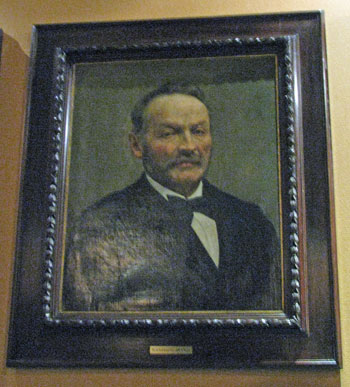
Bernardino was the original creator of the famous Fernet Branca, developing the formula with Dr. Fernet, a Swedish doctor, to assist malaria and cholera patients. With this aim, it was first tested in hospitals (where it was shown to help patients) and first sold in local farmacias, or pharmacies (quick aside: Italian pharmacists have a lot more leeway than those here in the States, in prescribing and diagnosing). The first cask that Bernardino made this herbal health mixture in is also in the museum, and lives right under his portrait:
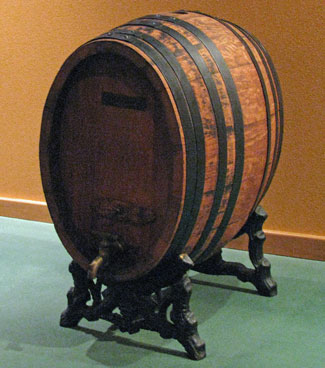
When walking through the museum, we learned more about the Branca family, which still runs the company today (the head of the company, Count Niccolo Branca, is the 5th generation of the family to make Fernet Branca). The family focus isn’t just with the Brancas, either, as our tour guide Marco is the 4th generation of his family to work at Branca (he’s been there since 1972). This lengthy dedication and devotion is quite remarkable, and shows in the end results: the liqueurs. There are lots more interesting family stories, such as those about Maria Scala, who married the third son of Bernardino and eventually became one of the first women in charge of a large company, and who originally developed the focus on continually creative Branca advertising—the company has always been on the forefront of advertising and advertising trends. One of my favorite, and a somewhat obscure, piece of marketing is this Branca suitcase:
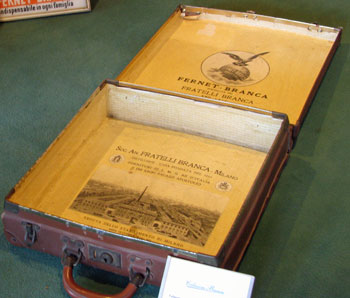
I would carry one of those in an instant (if you have one you’re tired of, please let me take it off your hands). The museum also has loads of production implements from the past, and some that were used in the past but are still utilized today, which points towards the Branca philosophy of novare serbando, or renew but conserve. For one example, Marco showed us these giant iron pots for herb maceration and heating, which are still used today, though the stirring is done mechanically instead of by hand:
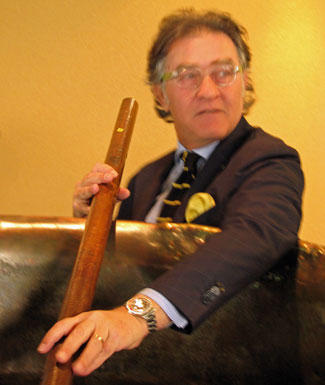
The pots were at one point stirred with both iron and wood stirrers (depending on the spices), and as the iron sticks were “cleaning” the pots, many thought that Fer-net came from some rendition of “clean iron.” Which is, I have to say, a great story. Fernet Branca gets its signature bitter, herbal, rich taste from an wide assortment of herbs, roots, spices, and other ingredients, and there’s a giant, mind-blowing, round table in the museum where you can see the complete layout of ingredients:
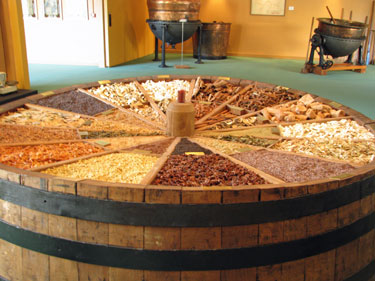
I knew (hey, I’ve done a little research before) that there were around 40 ingredients, and that the list included such far-reaching items as gentian root, rhubarb, myrrh, cinchona bark, galanga, saffron, and others, but I learned while there that all the products used are completely natural, and that all the suppliers have to sign a code of sorts, that says the products were obtained in a non-exploitive way. Another (and this was fascinating to me, but hey, I’m interested in odd things) fact I learned is that the real secret in the secret recipe for Fernet-Branca is how the ingredients are treated in production. Only the family knows, and the Count himself still does the treating (which means he has to go to the other distillery, in Argentina, regularly). Cool, isn’t it? After spices, we got to see tons of hip old Fernet-Branca ads, including the first one to use the eagle-over-the-world logo:
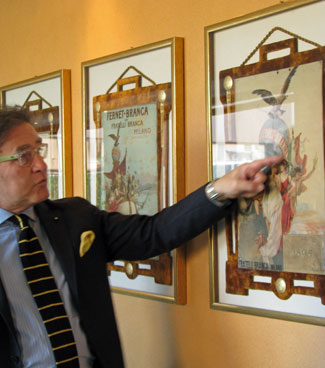
This logo was created in 1895, due to the large amount of Fernet Branca imitations being shuffled out of back alleys—always look for the eagle bringing the Branca over the world to ensure you get the real thing. There are a number of side rooms along the museum’s main path, where you can get a better picture of how Branca workers worked back in the day (as they say), with an herbalist’s room, chemist’s room:
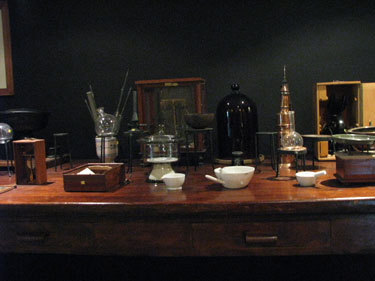
and more. The museum is persistent in remembering not just what was made, but those who made it—not to mention that the museum itself was built by current workers at the plant. Again, there’s that whole atmosphere of devotion to people and product, to stories and to history. After looking over the production process, the spices, and hearing about the history contained within, we walked into a room full of bottles, whole tables of old Fernet Branca bottles, and bottles of other products brought out by the company, including older bottles of Branca Menta (a minty-er and sweeter version of Fernet Branca released in 1965), bottles of Carpano Antica (Branca bought the Carpano company years ago in a particularly astute moment—Carpano Antica being the first Italian vermouth, and one still made partially by hand, and the Carpano company also making Italian vermouth Punt e’ Mes), and more bottles. There’s even a whole cabinet of Fernet Branca impersonators (I suppose success always leads to imitation):
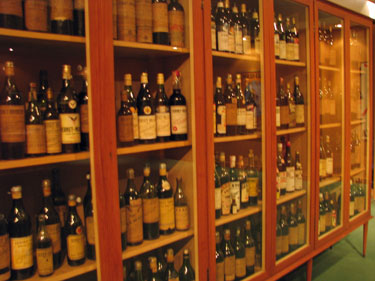
Then we stopped in the bar room (of course the museum was going to have a bar at some point), talked a bit more about advertising, had some Carpano Antica (which I loved even before stopping, and which I was happy to have a glass of even at 11:30 AM), and saw a host of happening ads for the non-Fernet-Branca-Branca brands. If the tour ended now, I would have been more than happy–but we still had the actual distillery to see! Which I’ll talk more about in Part 2, so come on back. Oh, first, check out this sweet and colorful Punt e’ Mes ad (one of about, say, 96, that I wished I had on my walls at home):
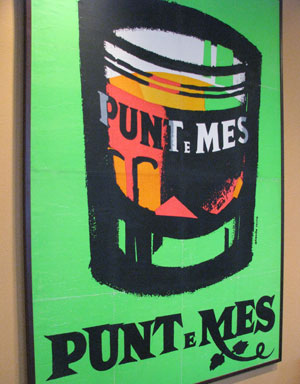
Tags: amaro, Branca Menta, Carpano Antica, Fernet Branca, Fratelli Branca Distillerie, Italian Liqueurs, Italy, Milan, Punt e' Mes
Posted in: Cocktail Art, digestif, Drinks on the Road, Fernet Branca, Italy, Liqueurs









































